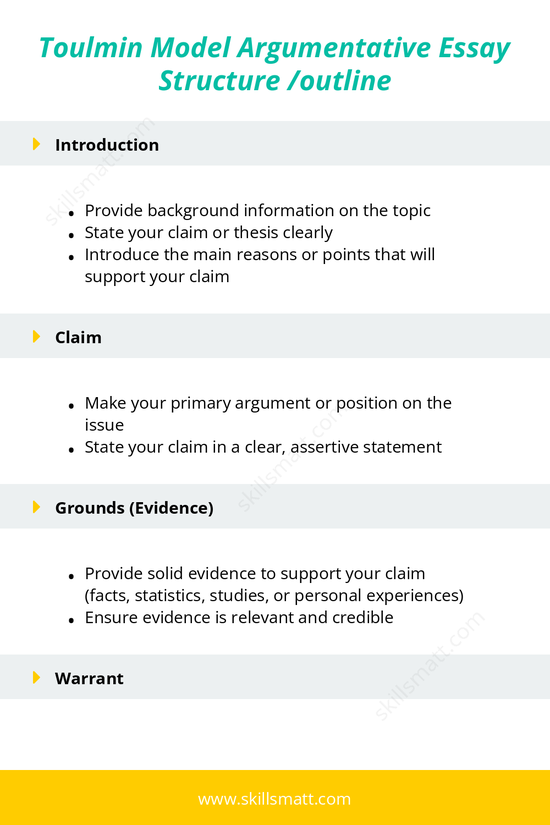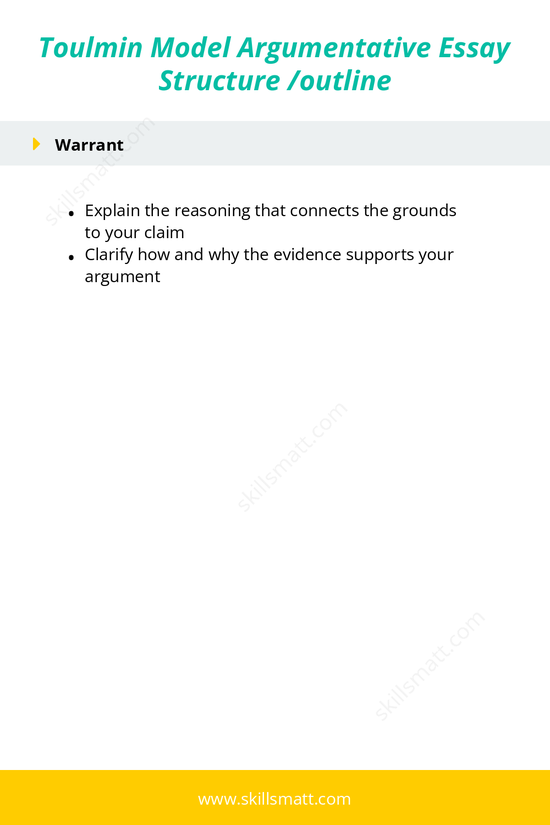The Toulmin Model is a powerful framework for structuring an argumentative essay. It provides a clear and logical way to present your argument and its supporting evidence, ensuring that your reasoning is both sound and persuasive. Below is an outline that follows the Toulmin Model, guiding you step by step on how to craft a compelling argumentative essay.
Introduction
The introduction serves as the foundation for your argument, providing essential background and clearly stating your position. It prepares the reader for what’s to come, helping them understand the issue and why it matters.
- Provide background information on the topic: Begin by giving some context on the topic at hand. Explain the relevance of the issue and why it deserves attention.
- State your claim or thesis clearly: Your thesis should outline your main argument in one or two sentences. It’s the central point you’ll be defending throughout the essay.
- Introduce the main reasons or points that will support your claim: Briefly mention the reasons or points you will use to support your claim in the body paragraphs.
Claim
The claim is the heart of your argument, where you state your position on the issue. This is where you assert your stance clearly and confidently.
- Make your primary argument or position on the issue: This is the central point you are arguing for. Make it specific, direct, and unambiguous.
- State your claim in a clear, assertive statement: Avoid vague language and ensure your claim is strong and declarative, setting the tone for the rest of your essay.
Grounds (Evidence)
For your claim to be convincing, you need to provide solid, credible evidence that backs it up. The grounds are the facts, data, or examples that support your position.
- Provide solid evidence to support your claim: Present statistics, facts, studies, or personal experiences that lend weight to your argument. The evidence should be well-researched and relevant to the issue at hand.
- Ensure evidence is relevant and credible: Use reputable sources to ensure that your evidence is both credible and persuasive. Avoid weak or biased sources that could undermine your argument.
Warrant
The warrant explains why the evidence you’ve provided supports your claim. It’s the reasoning that connects your evidence to the argument you’re making.
- Explain the reasoning that connects the grounds to your claim: Make it clear how and why the evidence you presented supports your position. Show the logical connection between the two.
- Clarify how and why the evidence supports your argument: Elaborate on the reasoning behind the evidence and how it directly bolsters your thesis.
Backing
The backing provides additional support for your warrant, strengthening your argument and adding more credibility to your reasoning.
- Provide additional support for the warrant: Introduce further research or expert opinions that reinforce the reasoning connecting your evidence to your claim.
- Strengthen the justification of your reasoning: Use these additional sources to solidify your reasoning, making your argument even more compelling.
Qualifier
In many cases, arguments are not absolute. The qualifier acknowledges the limitations of your claim, providing a sense of nuance and helping you avoid overgeneralization.
- Acknowledge the limits or scope of your argument: Recognize that your claim might not apply universally, and acknowledge any exceptions to your argument.
- Use qualifiers: Phrases like “most likely,” “in general,” or “usually” signal to the reader that your argument is not absolute, but rather flexible and thoughtful.
Rebuttal
The rebuttal is where you anticipate and address counterarguments to your claim. Addressing opposing views demonstrates that you’ve considered different perspectives and strengthens your position.
- Address potential counterarguments: Acknowledge opposing viewpoints and show that you are aware of other perspectives.
- Refute opposing views with logic or evidence: Use logical reasoning or evidence to dismantle opposing views, showing why your argument is still stronger.
Conclusion
The conclusion ties everything together. It’s where you restate your claim, summarize the reasoning and evidence, and leave the reader with a thought-provoking ending.
- Restate your claim and reinforce its validity: Restate your thesis in light of the evidence and reasoning presented, emphasizing why your argument holds up.
- Summarize your reasoning and evidence: Provide a brief overview of the key points that support your claim, reminding the reader of the strength of your argument.
- End with a strong statement that encourages further thought or action: Conclude with a powerful closing statement, whether it’s a call to action, a final reflection, or an invitation for the reader to consider the broader implications of the issue.
The Toulmin Model provides a clear and structured way to build and present an argumentative essay. By following this outline, you’ll be able to craft a well-reasoned and persuasive essay that clearly communicates your position, addresses counterarguments, and provides a compelling case for your viewpoint.


